Hip Hop Introduced in the 1970 as Visual Art
From cave paintings to Maurice Sendak, a look at the masters of the grade
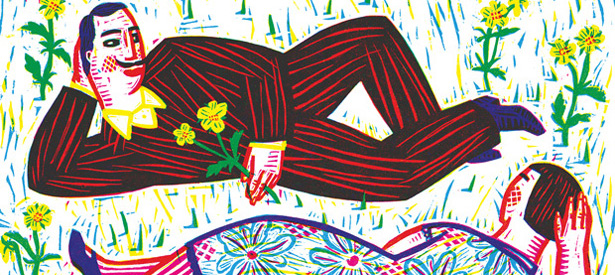
Dorsum in the fifteenth century, Leonardo da Vinci fabricated the following remark about visual storytelling:
"And yous who wish to represent past words the form of homo and all the aspects of his membrification, relinquish that idea. For the more minutely you describe the more you will confine the mind of the reader, and the more than you will keep him from the knowledge of the thing described. And so it is necessary to depict and to describe."
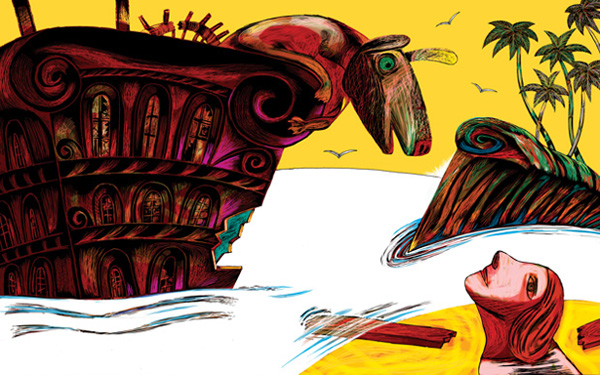
From very early on, we both intuit and larn the language of pictorial representation, and near modern adults, the picturebook was our first dictionary of this visual vocabulary. Yet the picturebook -- divers by its narrative framework of sequential imagery and minimalist text to convey pregnant or tell a story, and different from the illustrated volume in which pictures play a secondary narrative part, enhancing and decorating the narrative -- is a surprisingly nascent medium.
In Children's Picturebooks: The Art of Visual Storytelling, illustrator Martin Salisbury and children'southward literature scholar Morag Styles trace the fascinating evolution of the picturebook every bit a storytelling medium and a cultural agent, and peer into the hereafter to see where the medium might be going side by side, with case studies of seminal works, a survey of creative techniques, and peeks within the sketchbooks and creative process of prominent illustrators calculation dimension to this thoughtful and visually engrossing journey.
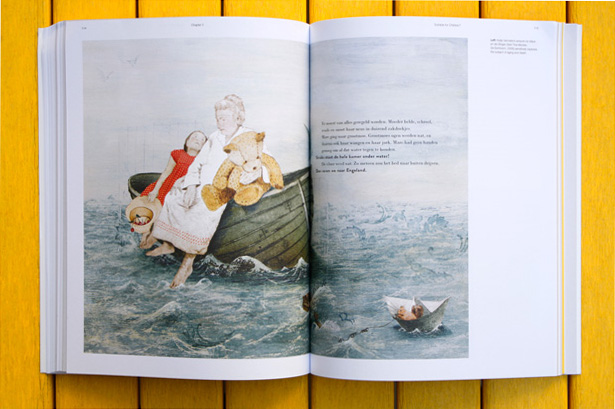
Though pictorial storytelling dates back to the primeval cave wall paintings, the true picturebook harks dorsum to a mere 130 years ago, when artist and illustrator Randolph Caldecott (1846-1886) outset began to drag the paradigm into a storytelling vehicle rather than mere decoration for text. Maurice Sendak, widely regarded as the greatest author of visual literature (though he refuses to place as a "children's author"), once wrote of Caldecott's "rhythmic syncopation" and its legacy:
"Caldecott's work heralds the kickoff of the modernistic pic book. He devised an ingenious juxtaposition of flick and word, a counter pint that never happened before. Words are left out -- but the movie says it. Pictures are left out -- but the words say information technology. In short, it is the invention of the picture book."
Even early on, tensions betwixt the creative vision and marketability of picturebooks captured the aforementioned friction between artist-storyteller and publisher that continues to plague children'south -- if not all -- publishing. Walter Crane (1845-1915), another Victorian-era picturebook innovator, famously grumbled about printer-publisher Edmund Evans' approach to publishing:
"...but it was not without protest from the publishers who idea the raw, coarse colours and vulgar designs usually current appealed to a larger public, and therefore paid better..."
(Evans, per Crane's remark, seemed to have taken on the role of a "circulation manager" of books, and with that came the aforementioned perception of compromised editorial integrity we've previously seen in the context of newspapers.)
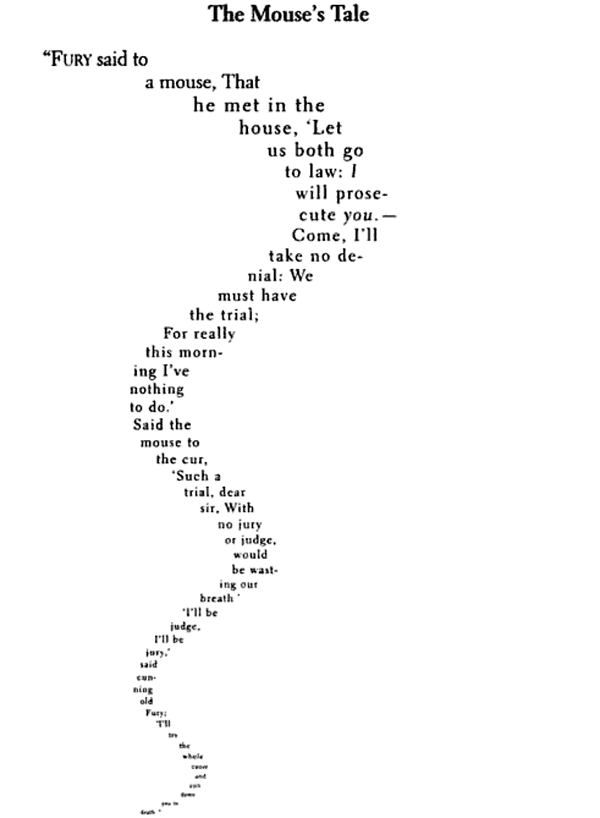
Lewis Carroll's The Mouse'southward Tale is an early instance of text taking the visual form of that which it describes or alludes to.
But the picturebook didn't fully bloom until the late nineteenth and early twentieth century, when new developments in printing technology, changing attitudes towards childhood, and a new grade of exceptional artists catapulted it into a golden age. The kickoff three decades of the twentieth century germinated such timeless classics as Curious George and the Babar stories. Merely as war consumed Europe, resource dwindled and the newspaper shortages of the post-war era placed new demands for keeping publishing costs depression. However despite, or peradventure because of, the thrift of the fourth dimension, there was a profound longing for color as escapism, which reined in the neo-romantic movement.
Then, in the 1950s, a peculiar cultural shift began to take place -- the line betwixt creative person and author started to blur, and a ingather of famous graphic designers ready out to write and illustrate picturebooks as a way of exploring visual thinking. (Just this week, 1 of the most celebrated such gems, the only children's book by the great Saul Bass, resurfaced to everyone's please.) Amongst the highlights of this new frontier was a series of children's picturebooks past legendary graphic designer -- and, paradoxically, notorious curmudgeon -- Paul Rand.
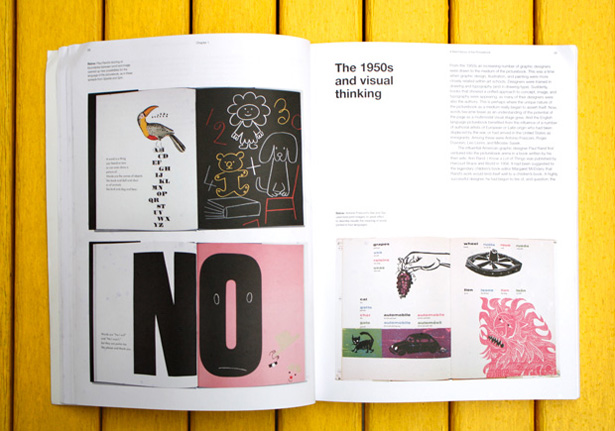
He and his then-wife, Ann, produced Sparkle and Spin (1957), Little 1 (1962), and Listen! Mind! (1970), all an practise in demonstrating "a playful but sophisticated understanding of the relationship between words and pictures, shapes, sounds, and thoughts." (Information technology was in the same period that Italian novelist and philosopher Umberto Eco introduced young readers to semiotics, the report of signs and symbols.)
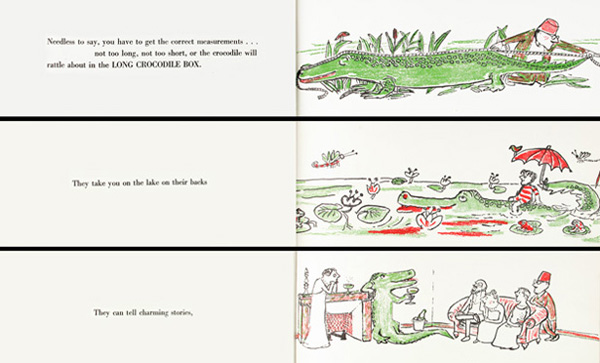
André François'due south Crocodile Tears (Universe Books NY, 1956) uses an extreme mural format to reflect and emphasize the discipline matter. It was François's first picturebook as writer-artist.
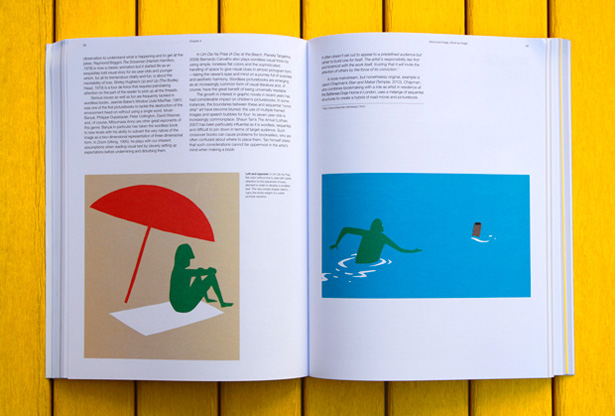
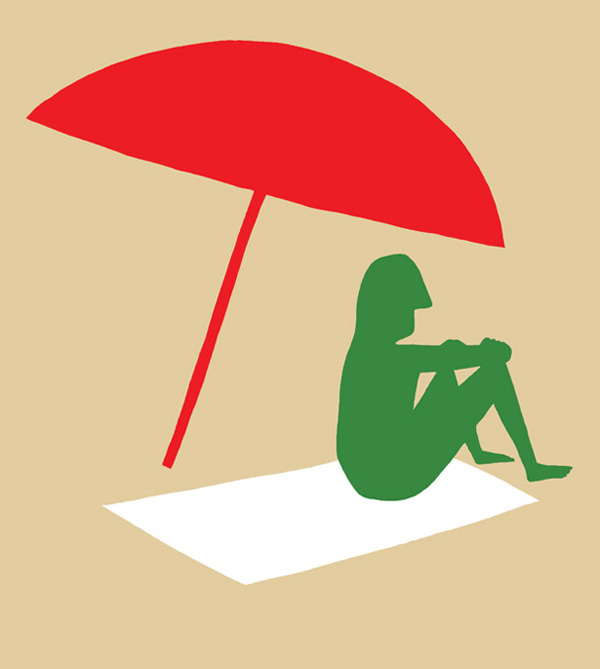
In Um Dia Na Praia, flat color without line is used with careful attention to the placement of every element in club to develop a wordless text. The very uncomplicated shapes need to comport the entire weight of a subtle pictorial narrative.
But many of these pioneering picturebook storytellers, just similar Sendak does to this day, had an disfavor to identifying as "children's book" authors. Salisbury and Styles write:
"Of course, many of the best picturebook artists would non describe themselves exclusively as such. André François was born in Hungary, in an area that became role of Romania after Globe War I. Simply it was as a French denizen that he spent his working life every bit a graphic artist, spanning visual satire, advertising and poster design, theater set design, sculpture, and book illustration. François's piece of work exhibited a childlike clumsiness that belied a highly sophisticated, biting eye."
(Sound familiar?)
In the 1960s, as a generation of British artists emerged from fine art school, picturebooks entered a new era of vibrant pigment and colour, with many artists combining volume illustration and painting to make a living. (Including, as nosotros've seen, Andy Warhol.) Information technology was in that era that some of the virtually influential picturebooks were built-in, including Maurice Sendak'due south most beloved piece of work and Miroslav Šašek's timeless This Is... serial.
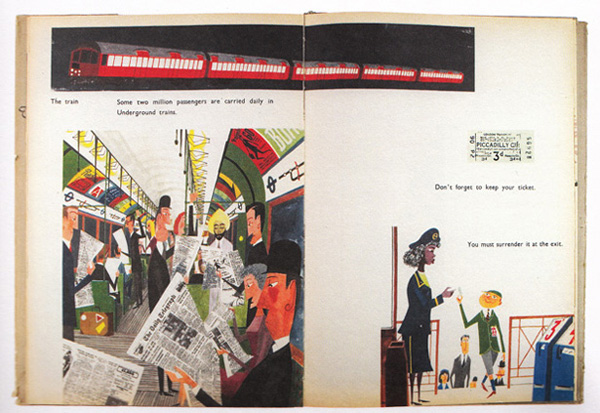
Miroslav Sasek'south 'This is...' series introduces children to countries and cities effectually the world. What distinguished them from many such books was the artist's eye for the anecdotal item of dissimilar cultures. This is London was published by MacMillan in 1959.
(Don't miss Šašek'southward lesser-known 1961 precious stone, Stone Is Non Cold, in which he brings to life famous sculptures from London, Rome and the Vatican City in irreverent vignettes from everyday life.)
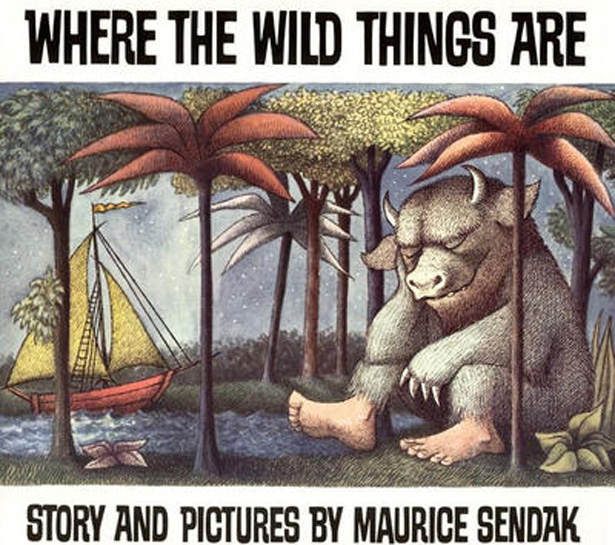
"Maurice Sendak may be the greatest illustrator for children of all time and was certainly one of the primeval to make an impact on educators and scholars, as well as on children, parents, and the creative community. Where The Wild Things Are (Harper & Row, 1963) was no Sendak'due south first picturebook, simply it was the outset one to brand a huge impression on children and adults alike. Interestingly, information technology caused a furore when it was published, with many critics anxious that information technology would be too terrifying for children."
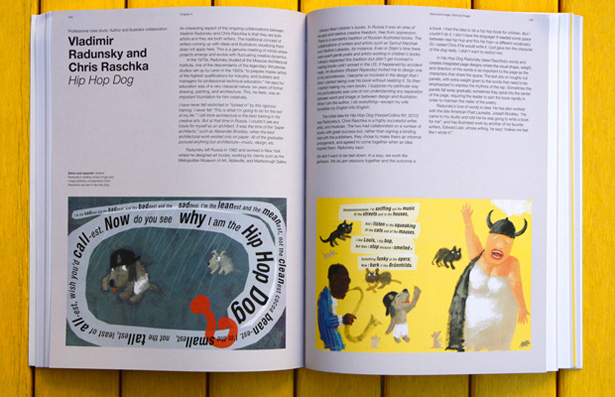
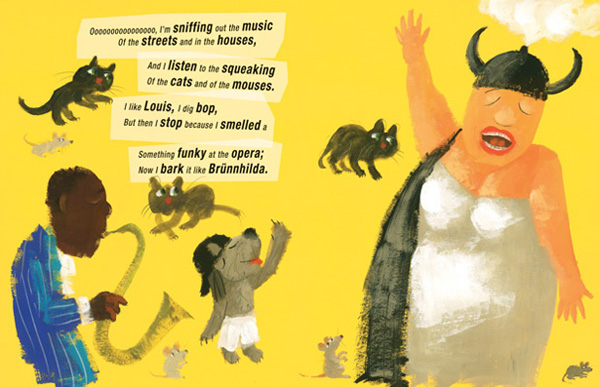
Vladimir Radunksy's swirling vortex of type and paradigm perfectly complements Chris Raschka'due south rap text in Hip Hop Domestic dog.
(You might recollect Vladimir Radunsky, to a higher place, from his fantastic illustrations for Mark Twain's Communication for Little Girls.)
But the volume's most fascinating feat is its discussion of the socially constructed and increasingly fluid criteria for what is suitable for children, with complex themes similar violence, sexual activity, decease and grief, and human rights violations turning picturebooks into a powerful crossover storytelling medium for all ages. Even some of the near dear storytelling of all fourth dimension, like The Brothers Grimm fairy tales and Arabian Nights, was aimed at children just often featured night, even savage, themes, and picturebooks have a documented history of radical politics.
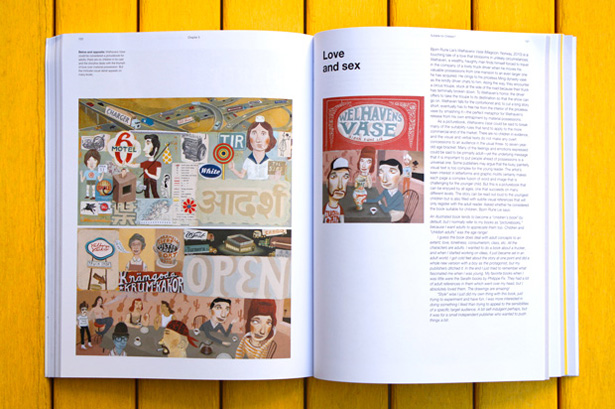
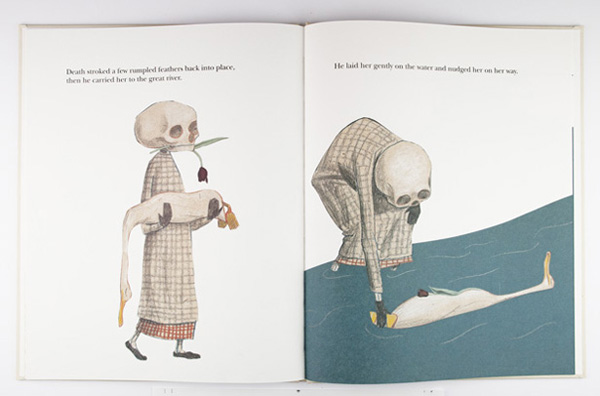
The bleak, uncompromising visual and verbal text of Wolf Erlbruch'south Duck, Death and the Tulip.
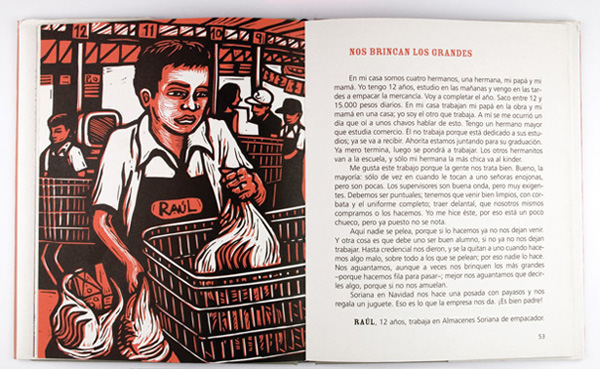
No Hay Tiempo Para Jugar / No Time to Play (text Sandra Arenal, illustrations Mariana Chiesa; Media Vaca, 2004). Produced in typical Media Vaca hardback format, the book gives voice to the child laborers of United mexican states in words and pictures.
Paradoxically -- and disappointingly to those of us who gloat the cantankerous-pollination of genres, ideas, and narratives -- traditional booksellers and the marketing departments of major publishers accept remained oddly stringent about how picturebooks are labeled and sold, confining them strictly to children'south literature. (For an case of just how short that sells them, run across Blexbolex'south fantastic, layered, remarkably thoughtful People, as delightful to kids as it is idea-provoking to adults -- yet it remains shelved in the children'due south section at the Big Corporate Bookstore.)
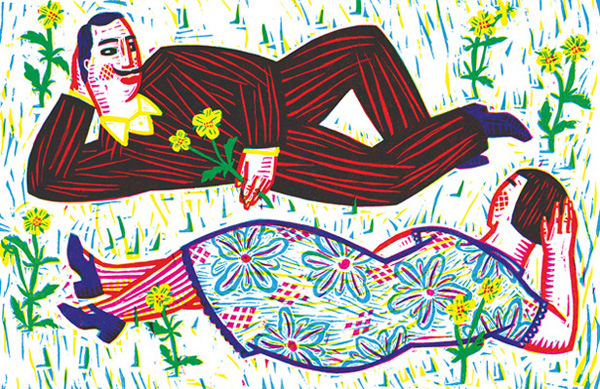
Color woodcuts past Isabelle Vandenabeele from Geert De Kockere's Vorspel Van Eeen Gebroken Liefde (De Eeenhoom, 2007)
The CJ Picture Book Festival in Republic of korea seems to go this crossover evolution, stating in its manifesto:
"Picture show books, in the present era, enjoy a condition as a civilisation form to be enjoyed by people of all ages. Information technology is a precious and versatile art that has already left the confines of newspaper backside, shattering the boundaries of its own genre and fusing with various other forms of art and imagery."
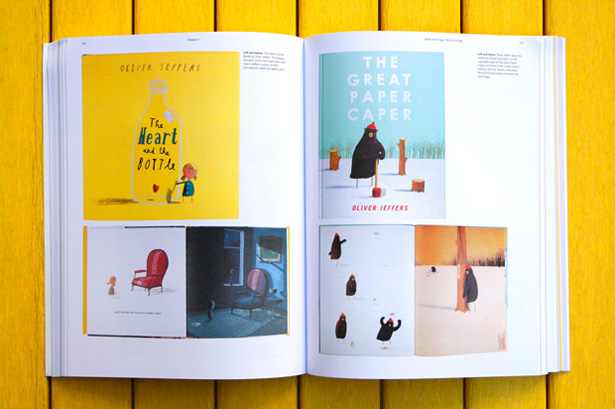
The unique developmental capacities of children, Salisbury and Styles point out, also shape the stylistic suitability of visual texts, presenting their own prepare of paradoxes and challenges:
"Many publishers and commentators express views almost the suitability or otherwise of artworks for children, even so there is no definitive enquiry that can tell united states of america what kind of imagery is most appealing or chatty to the young center. The perceived wisdom is that bright, primary colors are near constructive for the very young. The difficulty is that children of traditional picturebook age tend not to take the language skills to express in words what they are receiving from an paradigm. They tin also be suggestible and prone to saying what they imagine adults want to hear. So, fifty-fifty with the best designed inquiry projects, the world that children are experiencing volition inevitably remain something of a mystery to us."
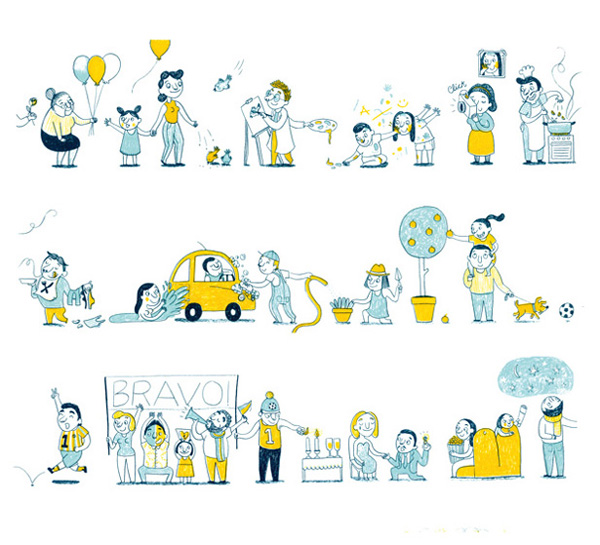
In her Chain of Happiness illustration, Marta Altes screen-prints with three colors.
Then where is this always-evolving medium headed? Salisbury and Styles cite gaming developer turned children's book illustrator Jon Skuse, who articulates both the tragedy and space potential of today'due south children's ebooks beautifully:
"The eBook isn't about winning or losing. It's almost an 'exploration,' and feel, rather like a pop-upwardly book. What many publishers are doing wrong at the moment is just copying printed picturebooks on to this format, which does both media a disservice. It's merely like looking at a PDF. Children will only flick through. A printed picturebook is a item kind of physical experience that can be savored and revisited. The eBook needs to exploit its ain particular characteristics and strengths to evolve as similarly special but distinct feel."
The authors conclude with a metaphor for the future of picturebooks borrowed from Lane Smith's fantastic It's a Book:
Perhaps the last word (or, rather, the last word and picture) should get to that modern chief of the idiom, Lane Smith. In his new picturebook, It's a Book (Roaring Volume Printing, 2010), Smith's ape tries to explain to Jackass that the thing he is belongings is called a book. Among the stream of questions asked by Jackass are: 'HOw do you scroll down?', 'Does it demand a password?', 'Tin can you tweet?' and 'Can you make the characters fight?'. When Jackass eventually gets the hang of this strange object, ape is forced to inquire 'Are you going to requite my book dorsum?'. 'No,' replies Jackass."
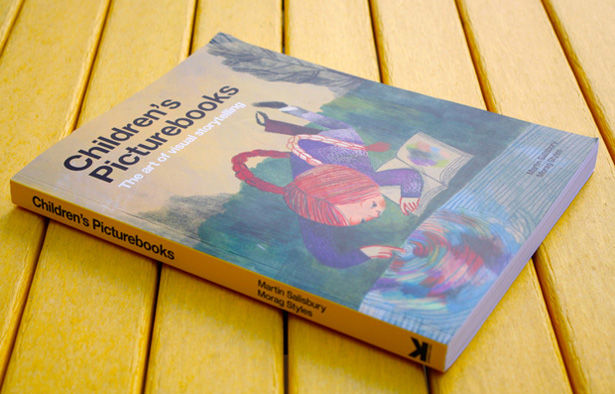
Every bit fascinating and rich equally Children's Picturebooks is, it suffers ane conspicuous contradiction -- with its concern with the format and future of the book, and its multitude of references to other books and historical materials, a kind of baked-in framework for truly networked knowledge, it would have, and should have, hands lent itself to the digital medium, where each of the dozens of books mentioned would be linked and explorable in rich media. Nevertheless, it remains a rigorously researched and compellingly curated survey of a tremendously important storytelling medium, 1 that equips immature minds with a cardinal understanding not only of the world just also of its visual language.

This postal service appears courtesy of Brain Pickings, an Atlantic partner site.
Image credits: Laurence Male monarch Publishers
We want to hear what you think about this article. Submit a letter to the editor or write to letters@theatlantic.com.
Maria Popova is the editor of Brain Pickings. She writes for Wired U.k. and Adept, and is an MIT Futures of Entertainment Fellow.
Source: https://www.theatlantic.com/entertainment/archive/2012/02/a-brief-history-of-childrens-picture-books-and-the-art-of-visual-storytelling/253570/
0 Response to "Hip Hop Introduced in the 1970 as Visual Art"
Postar um comentário